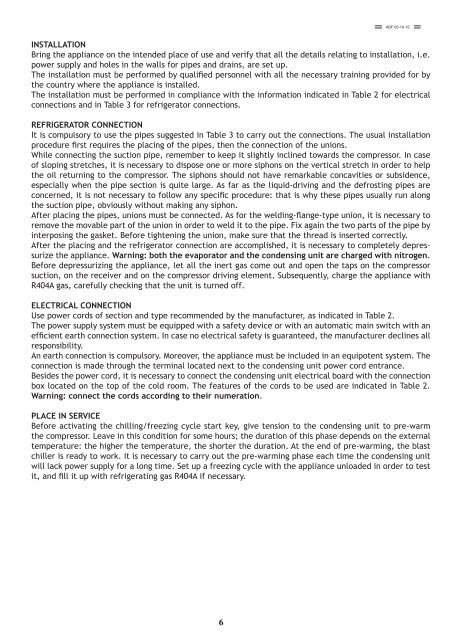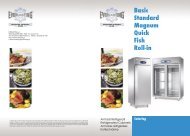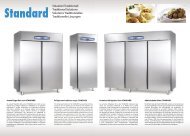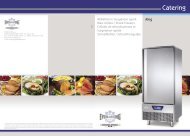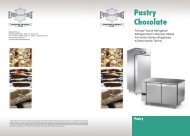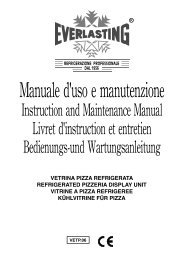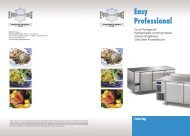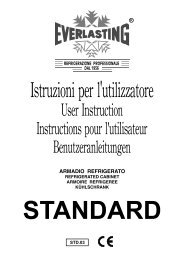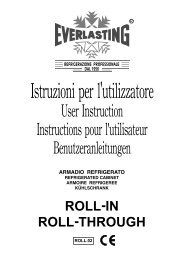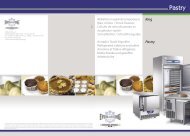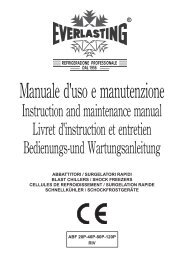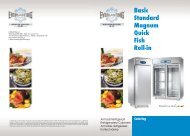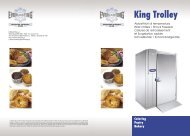MANUALE ABBATTITORI DI TEMPERATURA - Everlasting
MANUALE ABBATTITORI DI TEMPERATURA - Everlasting
MANUALE ABBATTITORI DI TEMPERATURA - Everlasting
Create successful ePaper yourself
Turn your PDF publications into a flip-book with our unique Google optimized e-Paper software.
6<br />
ABF 05-10-15<br />
INSTALLATION<br />
Bring the appliance on the intended place of use and verify that all the details relating to installation, i.e.<br />
power supply and holes in the walls for pipes and drains, are set up.<br />
The installation must be performed by qualified personnel with all the necessary training provided for by<br />
the country where the appliance is installed.<br />
The installation must be performed in compliance with the information indicated in Table 2 for electrical<br />
connections and in Table 3 for refrigerator connections.<br />
REFRIGERATOR CONNECTION<br />
It is compulsory to use the pipes suggested in Table 3 to carry out the connections. The usual installation<br />
procedure first requires the placing of the pipes, then the connection of the unions.<br />
While connecting the suction pipe, remember to keep it slightly inclined towards the compressor. In case<br />
of sloping stretches, it is necessary to dispose one or more siphons on the vertical stretch in order to help<br />
the oil returning to the compressor. The siphons should not have remarkable concavities or subsidence,<br />
especially when the pipe section is quite large. As far as the liquid-driving and the defrosting pipes are<br />
concerned, it is not necessary to follow any specific procedure: that is why these pipes usually run along<br />
the suction pipe, obviously without making any siphon.<br />
After placing the pipes, unions must be connected. As for the welding-flange-type union, it is necessary to<br />
remove the movable part of the union in order to weld it to the pipe. Fix again the two parts of the pipe by<br />
interposing the gasket. Before tightening the union, make sure that the thread is inserted correctly.<br />
After the placing and the refrigerator connection are accomplished, it is necessary to completely depressurize<br />
the appliance. Warning: both the evaporator and the condensing unit are charged with nitrogen.<br />
Before depressurizing the appliance, let all the inert gas come out and open the taps on the compressor<br />
suction, on the receiver and on the compressor driving element. Subsequently, charge the appliance with<br />
R404A gas, carefully checking that the unit is turned off.<br />
ELECTRICAL CONNECTION<br />
Use power cords of section and type recommended by the manufacturer, as indicated in Table 2.<br />
The power supply system must be equipped with a safety device or with an automatic main switch with an<br />
efficient earth connection system. In case no electrical safety is guaranteed, the manufacturer declines all<br />
responsibility.<br />
An earth connection is compulsory. Moreover, the appliance must be included in an equipotent system. The<br />
connection is made through the terminal located next to the condensing unit power cord entrance.<br />
Besides the power cord, it is necessary to connect the condensing unit electrical board with the connection<br />
box located on the top of the cold room. The features of the cords to be used are indicated in Table 2.<br />
Warning: connect the cords according to their numeration.<br />
PLACE IN SERVICE<br />
Before activating the chilling/freezing cycle start key, give tension to the condensing unit to pre-warm<br />
the compressor. Leave in this condition for some hours; the duration of this phase depends on the external<br />
temperature: the higher the temperature, the shorter the duration. At the end of pre-warming, the blast<br />
chiller is ready to work. It is necessary to carry out the pre-warming phase each time the condensing unit<br />
will lack power supply for a long time. Set up a freezing cycle with the appliance unloaded in order to test<br />
it, and fill it up with refrigerating gas R404A if necessary.


